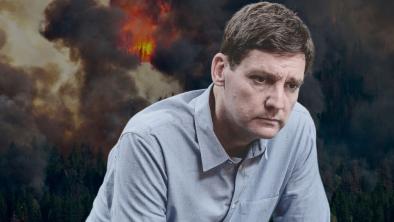DL33: A forest runs through it
Parksville Qualicum Beach News

Alberni-Pacific Rim MLA, Scott Fraser snaps a picture as Western Canada Wilderness Committee head Annette Tanner (right) looks on during on a recent hike of the DL33 property. Lissa Alexander photo
In their effort to save a parcel of endangered Coastal Douglas Fir (CDF) forest, The Western Canada Wilderness Committee invited a number of ministers, MLAs, directors, members of the Nanoose First Nation and environmental groups to tour the land on Friday to see why it’s worth saving.
“We invited them to come and see first-hand what they’ve been receiving many letters and faxes and e-mail and phone calls about,” said Annette Tanner, chairperson with the WCWC. “We have to think of our future communities and future children and leave some forest for them to see with their kids.”
The Minister of Forests and Range, Minister of Environment, Minister of Aboriginal Affairs and Parksville-Qualicum MLA Ron Cantelon were just a few of the politicians on the list who were invited to attend the forest tour.
But in the end Scott Fraser, MLA of Alberni-Pacific Rim, and Barry Avis, Qualicum Beach councillor, were the only politicians to attend.
In a recent report by the Forest Practices Board, B.C’s independent watchdog for sound forest practices, it was revealed that the B.C. government did not abide by an earlier commitment not to issue a new forest tenure in the CDF until a conservation strategy was created to protect sensitive and ecologically important areas.
Minister of Forest and Range Pat Bell said the land, known as District Lot 33, would not be considered for protection anyway, as his professional biologist determined that it is not “prime forest.” However, it states in the Forest Practices Board Report that a recent ground check by an independent ecologist confirmed that all of DL33 is CDF, in good condition. Bell said they will review the report and will determine whether or not they have made an error.
The Snaw-Naw-As First Nations in Nanoose currently hold a woodlot license for the land and are awaiting a cutting permit in order to log this summer.
About a dozen people took to the trail, including A-Channel News, to tour the Crown land. This CDF forest occurs only in B.C. and parts of Washington State. Of all the CDF land remaining, 80 per cent is on private land, and only 9 percent is on provincial Crown land. Barry Avis is also president of the Association of Vancouver Island Coastal Communities, representing all the mayors and councillors on the Island, and has helped pass a resolution with that association to help try and protect this land.
“It’s an absolute essential resource,” he said. “We have such a little amount of Crown land left... with Crown land it should be very easy to protect it. And if it’s a matter of resources and finances, it’s kind of frustrating that the First Nations have been brought into the argument, there’s other ways of compensating the First Nations folks.
Alberni-Pacific Rim Scott Fraser said the problem with ecosystem protection in B.C. is that the Ministry of Environment’s staff has been “decimated,” making decisions without getting the facts on the ground.
“The staffing has been cut, the levels are at such a rate where the Ministry and the Minister don’t even know what’s on the ground on a regional area to area basis,” he said. “So we’re seeing a shot gun approach made at guestimates at best from the Ministry.”
All the pertinent information being gathered by other professionals and sent to the Ministry is being ignored, Fraser said, which in his opinion, is “criminal.”
Band administrator with the Nanoose First Nation, Brent Edwards, said that the Forest Practices Board Report also underscores an important fact, that while DL33 is an issue, it’s not the real issue. The real issue, Edwards said, is that 80 percent of CDF is on private land. This land should be protected instead of the little amount Crown land remaining that could be used to settle some outstanding long term rights entitlement agreements with the First Nations.
“One day those parcels of land may be provided to Nanoose First Nation as part of a land deal, so people are going to have to get used to Nanoose First Nation and the province negotiating in good faith to access these properties,” he said. “Whether they’re there for living or infrastructure or for resource removal, the Nanoose First Nation isn’t going away, we’re going to have to work with our neighbors,” he said.
Edwards said the logging of DL33 will raise a lot of capital to support some of their projects and to support the band, explaining that they have 70 children under the age of seven and 98 houses on the reserve.
When asked if they would be receptive to a cash settlement, Edwards said it has never been brought to them by the province, and neither local or provincial governments are going to be able to come up with that kind of money.
“Really, they are not going to come up with a million dollars,” he said. Plus, they are not looking to renegotiate, he added. “We are not looking to negotiate any further agreements, we have one and we’re moving forward with it.”
After the hike, Fraser said that he would followup with a stern letter to the Minister of Forests and Minister of the Environment again, but that ultimately they need to be embarrassed before they will act.
“We have to embarrass them,” he said, “and unfortunately, no government policy should be made by embarrassment, it should be made by sound scientific ecological facts,” he said.
The WCWC is planning a tour of DL33 for the general public on Saturday, July 10 at 11 a.m. Those who would like to attend meet at the Petrocan station in Nanoose Bay at 11 a.m. (2345 Island Hwy East).


